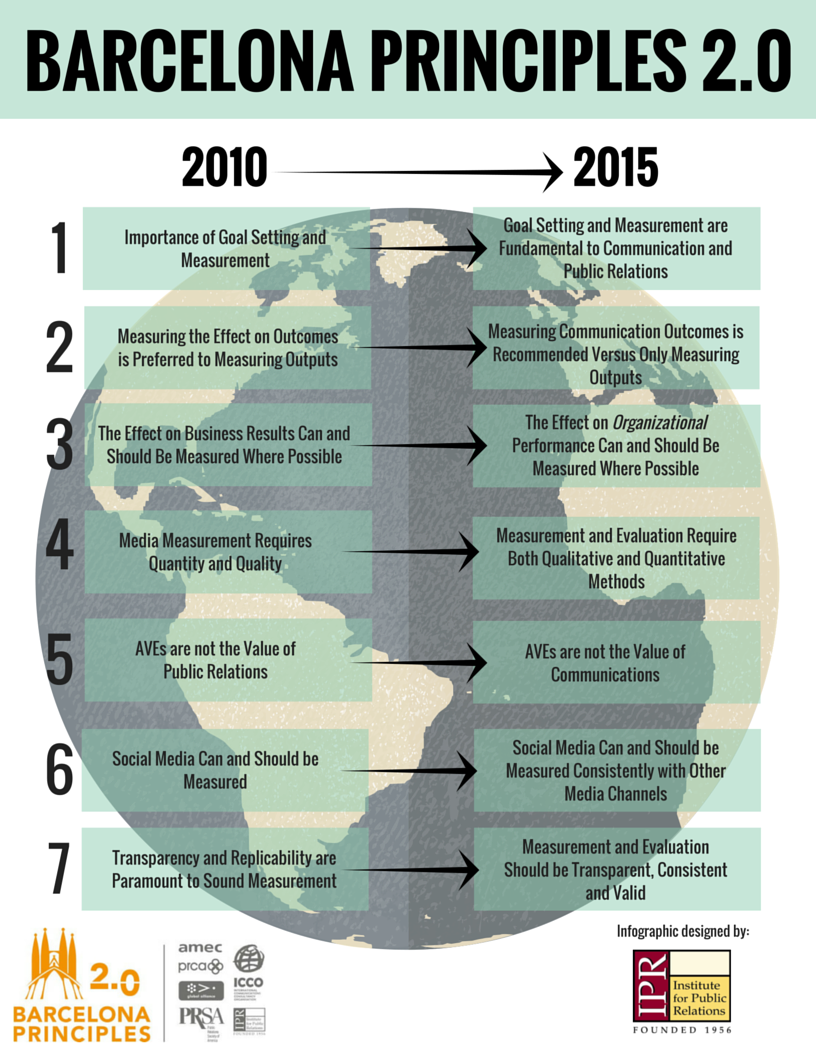Barcelona Principles Reloaded
An international working group reviewed the original Barcelona Principles during this summer. It consisted of the original partners involved in the Barcelona Principles of 2010: AMEC, ICCO, IPR, PRCA, PRSA and The Global Alliance. It’s been five years since the industry rallied around the Barcelona Declaration of Measurement Principles, agreeing to a first outline of an overarching framework for effective public relations and communication measurement.
The original goal was straightforward: provide guidelines to measure efficacy of communication campaigns; provide a basis to enable the replacement of outdated program measurement models and ultimately to end years of debate as to whether metrics such as AVEs and multipliers should be used. „Our working group has identified ways to build upon the original Barcelona Principles and make them even more reflective of the industry and the way communication professionals work today“, said David Rockland, Chairman of the Barcelona Principles 2.0 Working Group.
How the Barcelona Principles have been updated
While the Barcelona Principles were intended to provide a foundation for measuring PR programs, the updated Principles recognize that they can be applied to many more areas of communication in any organization, government, company or brand. In fact, measurement, evaluation and goal-setting should be holistic across media whether paid, earned, owned or shared channels. In order to show how the Principles has been updated, the Institute of PR provides the following illustration:

Source: Institute for PR
More details on the update you can find here.
Why change was necessary
In a recent article for AMEC Rockland constitutes why change was necessary. Where the original set of Principles focused more on “what not to do,” the updated Barcelona Principles of 2015 provide more guidance on “what to do,” in order to unite the ever-expanding media landscape into a transparent, reliable, and consistent measurement and evaluation framework. According to Rockland, Barcelona Principles 2.0 goes beyond the PR sector and outlines more overall applications for communications measurement. The revised Principles include greater attention to the role of qualitative methods alongside quantitative methods. The Barcelona Principles of 2015 also acknowledge the realities of working in an increasingly integrated field. Rockland summarizes: „A lot has changed over the past five years, but one factor remains constant: as practitioners, we must always be prepared to prove our value and the ROI of communication. As a set of professional measurement guidelines and practices, our goal is to ensure that The Barcelona Principles continue to act as a baseline that professionals can use today and in the future.“
Key points of the revised Barcelona Principles
1. Widening the scope beyond PR measurement: changing the language to makeclear that the principles are relevant and applicable to organizations, governments, companies and brands worldwide.
2. Reinforcing the importance of integration: recognizing the importance of integrated communications across geographies, methods (quantitative and qualitative), and channels (including paid, earned, owned, and shared media).
3. Making a clear distinction between measurement and evaluation: separating the role of measurement from the role of evaluation as the actual process of using data to make a judgement on value and effectiveness.
4. Including a new focus on qualitative assessment: acknowledging the rolethat qualitative information plays in measurement and evaluation, adding color and context that helps professionals understand “the why” behind the outcomes.
5. Reminding professionals of the need for all measurement and evaluation to be transparent, consistent and valid: giving more advice on established approaches and methodologies.
Conclusion
The changes are not fundamental. The Barcelona Principles 2.0 still remain guidelines for good evaluation of communication processes in particular. Unlike German approaches, controlling and management issues are not explicitly mentioned here.
back to News


